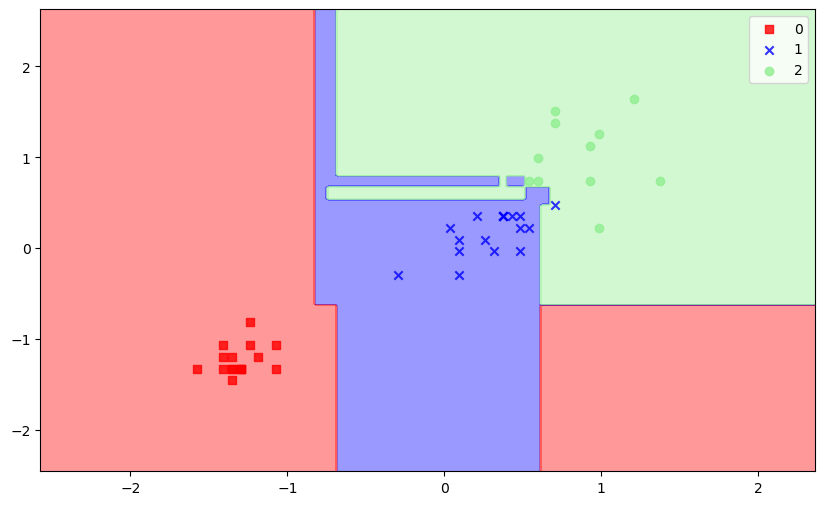一、Iris数据集介绍
A small classic dataset from Fisher, 1936. One of the earliest datasets used for evaluation of classification methodologies.
[更多数据集信息]
[文章算法来源:Visualizing KNN, SVM, and XGBoost on Iris Dataset、ML from Scratch with IRIS!!]
二、预览数据与处理
1、导入模块和数据集
# ----------导入模块和数据集----------
import pandas as pd
import numpy as np
from sklearn import datasets
iris = datasets.load_iris()
# 我们将仅使用花瓣的长度和宽度进行此分析
X = iris.data[:, [2, 3]]
y = iris.target
# 将鸢尾花数据放入pandas DataFrame中
iris_df = pd.DataFrame(iris.data[:, [2, 3]], columns=iris.feature_names[2:])
# 查看数据的前5行
print(iris_df.head())
# 打印数据集的唯一标签
print('\n' + 'The unique labels in this data are ' + str(np.unique(y)))
''' 输出:
petal length (cm) petal width (cm)
0 1.4 0.2
1 1.4 0.2
2 1.3 0.2
3 1.5 0.2
4 1.4 0.2
The unique labels in this data are [0 1 2]
'''2、分割数据集
# ----------导入模块和数据集----------
from sklearn import datasets
iris = datasets.load_iris()
# 我们将仅使用花瓣的长度和宽度进行此分析
X = iris.data[:, [2, 3]]
y = iris.target
# ----------分割数据集----------
from sklearn.model_selection import train_test_split
# 将数据集分为训练和测试数据集
X_train, X_test, y_train, y_test = train_test_split(X, y, test_size=.3, random_state=0)
print('There are {} samples in the training set and {} samples in the test set'
.format(X_train.shape[0], X_test.shape[0]))
''' 输出:
There are 147 samples in the training set and 3 samples in the test set
'''3、数据预处理:标准化数据
# ----------导入模块和数据集----------
import pandas as pd
from sklearn import datasets
iris = datasets.load_iris()
# 我们将仅使用花瓣的长度和宽度进行此分析
X = iris.data[:, [2, 3]]
y = iris.target
# 将鸢尾花数据放入pandas DataFrame中
iris_df = pd.DataFrame(iris.data[:, [2, 3]], columns=iris.feature_names[2:])
# ----------分割数据集----------
from sklearn.model_selection import train_test_split
# 将数据集分为训练和测试数据集
X_train, X_test, y_train, y_test = train_test_split(X, y, test_size=.3, random_state=0)
# ----------数据预处理:标准化数据----------
from sklearn.preprocessing import StandardScaler
# X_scaled = (X - X.mean()) / X.std()
# 其中, X.mean()为数据集的均值, X.std()为数据集的标准差
sc = StandardScaler()
sc.fit(X_train)
X_train_std = sc.transform(X_train)
X_test_std = sc.transform(X_test)
print('After standardizing our features, the first 5 rows of our data now look like this:\n')
print(pd.DataFrame(X_train_std, columns=iris_df.columns).head())
''' 输出:
After standardizing our features, the first 5 rows of our data now look like this:
petal length (cm) petal width (cm)
0 1.438873 0.794200
1 -1.283757 -1.321269
2 1.268708 1.719718
3 -1.397200 -1.189052
4 0.531329 0.397550
'''4、查看数据分布
# ----------导入模块和数据集----------
import numpy as np
from sklearn import datasets
iris = datasets.load_iris()
# 我们将仅使用花瓣的长度和宽度进行此分析
X = iris.data[:, [2, 3]]
y = iris.target
# ----------分割数据集----------
from sklearn.model_selection import train_test_split
# 将数据集分为训练和测试数据集
X_train, X_test, y_train, y_test = train_test_split(X, y, test_size=.3, random_state=0)
# ----------查看数据分布----------
import matplotlib.pyplot as plt
from matplotlib.colors import ListedColormap
# 设置画布尺寸
plt.figure(figsize=(10, 6))
# s: 正方形 x: x型 o: 圆形
markers = ('s', 'x', 'o')
colors = ('red', 'blue', 'lightgreen')
classes = ('Setosa', 'Versicolour', 'Virginica')
cmap = ListedColormap(colors[:len(np.unique(y_test))])
for idx, cl in enumerate(np.unique(y)):
plt.scatter(x=X[y == cl, 0], y=X[y == cl, 1], color=cmap(idx),
marker=markers[idx], label=classes[cl])
# 创建图例
plt.legend()
plt.show()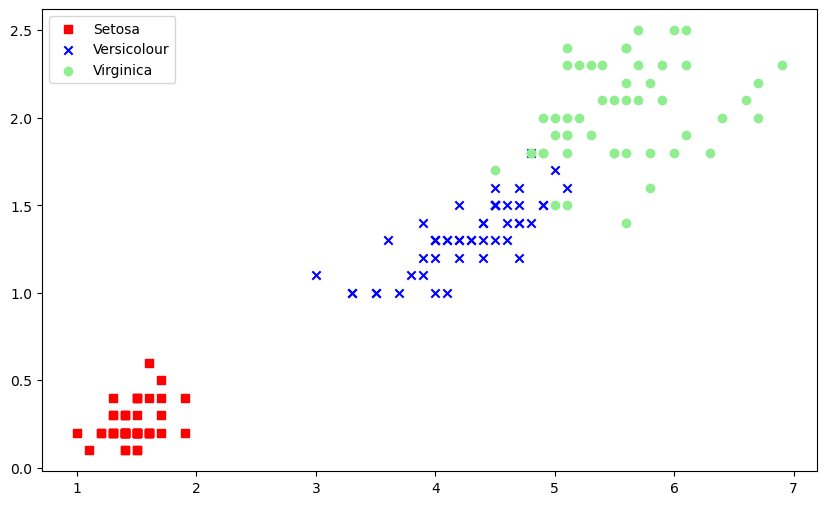 我们可以看到其中Setosa是线性可分离的,但另外两个不是。
我们可以看到其中Setosa是线性可分离的,但另外两个不是。
5、标准化数据集
# ----------导入模块和数据集----------
import numpy as np
from sklearn import datasets
iris = datasets.load_iris()
# 我们将仅使用花瓣的长度和宽度进行此分析
X = iris.data[:, [2, 3]]
y = iris.target
# ----------分割数据集----------
from sklearn.model_selection import train_test_split
# 将数据集分为训练和测试数据集
X_train, X_test, y_train, y_test = train_test_split(X, y, test_size=.3, random_state=0)
# ----------数据预处理:标准化数据----------
from sklearn.preprocessing import StandardScaler
# X_scaled = (X - X.mean()) / X.std()
# 其中, X.mean()为数据集的均值, X.std()为数据集的标准差
sc = StandardScaler()
sc.fit(X_train)
X_train_std = sc.transform(X_train)
X_test_std = sc.transform(X_test)三、图形化数据分布
1、导包
Seaborn:Seaborn is a Python data visualization library based on matplotlib. It provides a high-level interface for drawing attractive and informative statistical graphics.
import numpy as np
import pandas as pd
import seaborn as sns
import matplotlib.pyplot as plt
from sklearn import datasets2、预览数据
iris_dataset = datasets.load_iris()
iris = pd.DataFrame(iris_dataset.data, columns=iris_dataset.feature_names)
print(iris.head(2))
''' 输出:
sepal length (cm) sepal width (cm) petal length (cm) petal width (cm)
0 5.1 3.5 1.4 0.2
1 4.9 3.0 1.4 0.2
'''
print(iris.info())
''' 输出:
<class 'pandas.core.frame.DataFrame'>
RangeIndex: 150 entries, 0 to 149
Data columns (total 4 columns):
# Column Non-Null Count Dtype
--- ------ -------------- -----
0 sepal length (cm) 150 non-null float64
1 sepal width (cm) 150 non-null float64
2 petal length (cm) 150 non-null float64
3 petal width (cm) 150 non-null float64
dtypes: float64(4)
memory usage: 4.8 KB
None
'''3、处理数据
iris_dataset = datasets.load_iris()
iris = pd.DataFrame(iris_dataset.data, columns=iris_dataset.feature_names)
target_set = ['Iris-setosa', 'Iris-versicolor', 'Iris-virginica']
iris.loc[:, 'Species'] = [target_set[iris_dataset.target[i]] for i in range(len(iris_dataset.target))]
iris = iris.rename(columns={'sepal length (cm)': 'SepalLengthCm',
'sepal width (cm)': 'SepalWidthCm',
'petal length (cm)': 'PetalLengthCm',
'petal width (cm)': 'PetalWidthCm'}, errors="raise")4、查看数据分布
萼片长度和萼片宽度关系图
fig = iris[iris.Species == 'Iris-setosa'].plot(kind='scatter', x='SepalLengthCm', y='SepalWidthCm', color='orange',
label='Setosa')
iris[iris.Species == 'Iris-versicolor'].plot(kind='scatter', x='SepalLengthCm', y='SepalWidthCm', color='blue',
label='versicolor', ax=fig)
iris[iris.Species == 'Iris-virginica'].plot(kind='scatter', x='SepalLengthCm', y='SepalWidthCm', color='green',
label='virginica', ax=fig)
fig.set_xlabel("Sepal Length")
fig.set_ylabel("Sepal Width")
fig.set_title("Sepal Length VS Width")
fig = plt.gcf()
fig.set_size_inches(10, 6)
plt.show()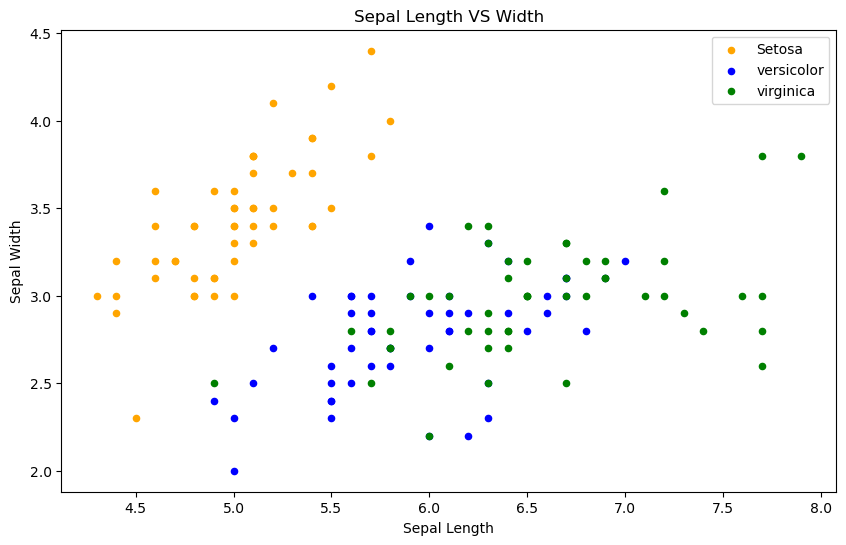
花瓣长度和花瓣宽度关系图
fig = iris[iris.Species=='Iris-setosa'].plot.scatter(x='PetalLengthCm',y='PetalWidthCm',color='orange', label='Setosa')
iris[iris.Species=='Iris-versicolor'].plot.scatter(x='PetalLengthCm',y='PetalWidthCm',color='blue', label='versicolor',ax=fig)
iris[iris.Species=='Iris-virginica'].plot.scatter(x='PetalLengthCm',y='PetalWidthCm',color='green', label='virginica', ax=fig)
fig.set_xlabel("Petal Length")
fig.set_ylabel("Petal Width")
fig.set_title(" Petal Length VS Width")
fig=plt.gcf()
fig.set_size_inches(10,6)
plt.show()
正如我们所看到的,与萼片特征相比,花瓣特征提供了更好的聚类划分。这表明花瓣可以帮助对萼片进行更好、准确的预测。我们稍后再检查。
花瓣和萼片数据分布情况
iris.hist(edgecolor='black', linewidth=1.2)
fig = plt.gcf()
fig.set_size_inches(12, 6)
plt.show()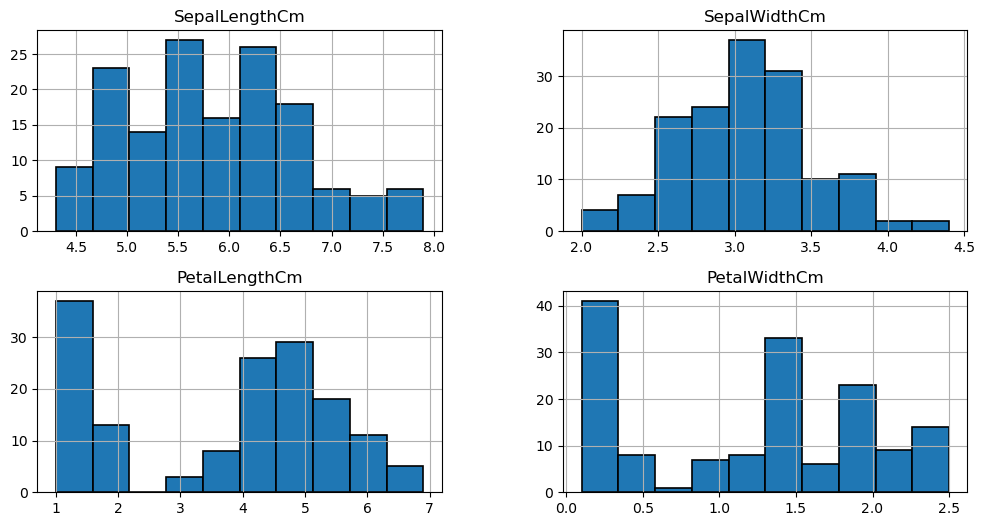
长度、宽度和物种之间关系图
plt.figure(figsize=(15, 10))
plt.subplot(2, 2, 1)
sns.violinplot(x='Species', y='PetalLengthCm', data=iris)
plt.subplot(2, 2, 2)
sns.violinplot(x='Species', y='PetalWidthCm', data=iris)
plt.subplot(2, 2, 3)
sns.violinplot(x='Species', y='SepalLengthCm', data=iris)
plt.subplot(2, 2, 4)
sns.violinplot(x='Species', y='SepalWidthCm', data=iris)
plt.show()小提琴图显示了物种长度和宽度的密度。越薄的部分表示密度越低,而越胖的部分则表示密度越高。
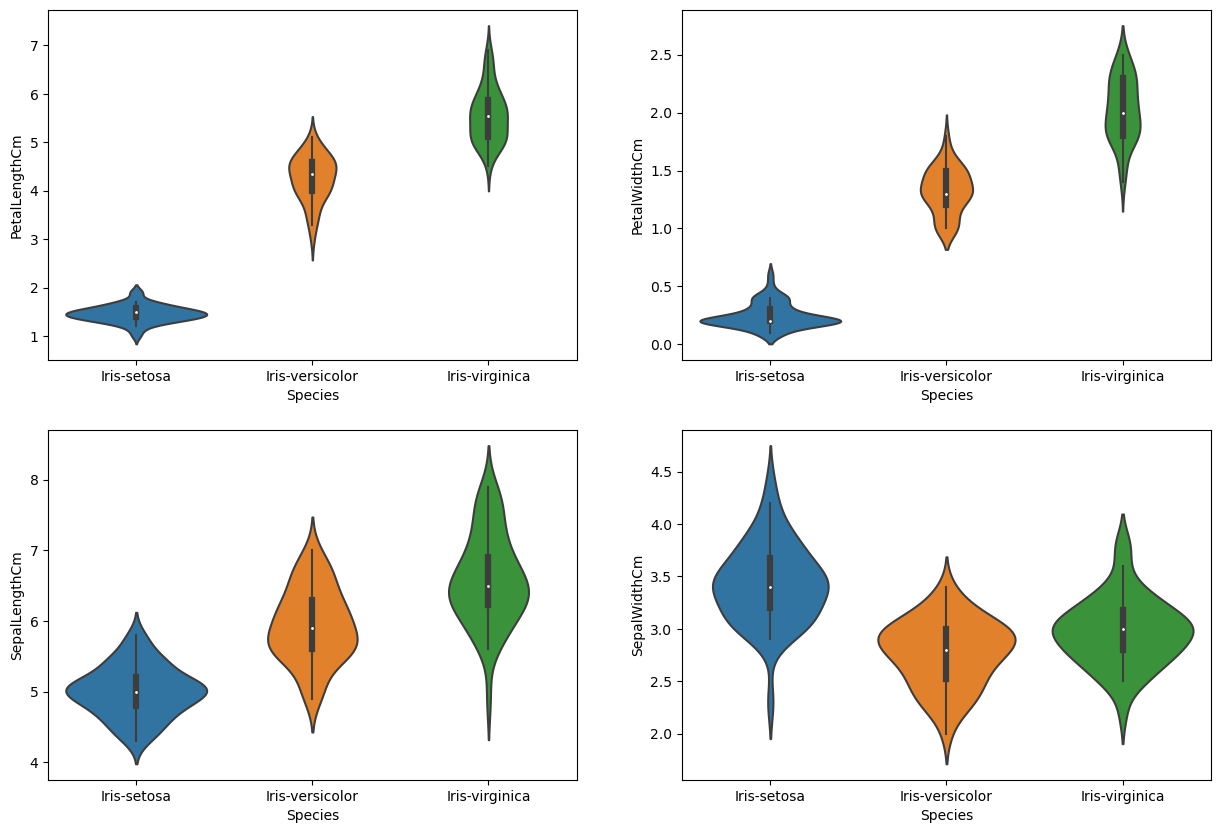
热力图
plt.figure(figsize=(7, 4))
sns.heatmap(iris.drop('Species', axis=1).corr(), annot=True, cmap='cubehelix_r')
plt.show()萼片宽度和长度不相关花瓣宽度和长度高度相关。
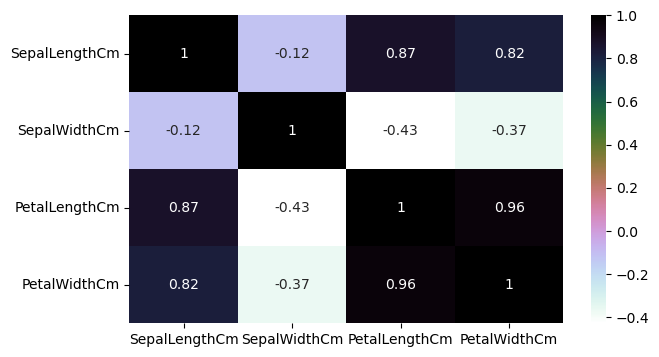
三、线性回归(Linear Regression)
训练
# ----------标准化数据集----------
# 参考标准化数据集
# ----------LR----------
from sklearn.linear_model import LinearRegression
lr = LinearRegression()
lr.fit(X_train_std, y_train)
print('The accuracy of the linear regression classifier is {:.2f} out of 1 on training data'
.format(lr.score(X_train_std, y_train)))
print('The accuracy of the linear regression classifier is {:.2f} out of 1 on test data'
.format(lr.score(X_test_std, y_test)))
''' 输出:
The accuracy of the linear regression classifier is 0.93 out of 1 on training data
The accuracy of the linear regression classifier is 0.91 out of 1 on test data
'''可视化方法
# ----------SVC可视化方法----------
import numpy as np
import matplotlib.pyplot as plt
from matplotlib.colors import ListedColormap
def plot_decision_regions(X, y, classifier, test_idx=None, resolution=0.02):
# 设置画布尺寸
plt.figure(figsize=(10, 6))
markers = ('s', 'x', 'o', '^', 'v')
colors = ('red', 'blue', 'lightgreen', 'gray', 'cyan')
classes = ('Setosa', 'Versicolour', 'Virginica')
cmap = ListedColormap(colors[:len(np.unique(y))])
# 绘制决策边界
x1_min, x1_max = X[:, 0].min() - 1, X[:, 0].max() + 1
x2_min, x2_max = X[:, 1].min() - 1, X[:, 1].max() + 1
# meshgrid将x中每一个数据和y中每一个数据组合生成很多点,然后将这些点的x坐标放入到X中,y坐标放入Y中,并且相应位置是对应的
xx1, xx2 = np.meshgrid(np.arange(x1_min, x1_max, resolution),
np.arange(x2_min, x2_max, resolution))
Z = classifier.predict(np.array([xx1.ravel(), xx2.ravel()]).T)
Z = Z.reshape(xx1.shape)
# 画出不同分类的边界线
plt.contourf(xx1, xx2, Z, alpha=0.4, cmap=cmap)
plt.xlim(xx1.min(), xx1.max())
plt.ylim(xx2.min(), xx2.max())
for idx, cl in enumerate(np.unique(y)):
plt.scatter(x=X[y == cl, 0], y=X[y == cl, 1],
alpha=0.8, c=cmap(idx), marker=markers[idx], label=cl)
# 创建图例
plt.legend()
plt.show()可视化
# ----------标准化数据集----------
# 参考标准化数据集
# ----------LR----------
from sklearn.linear_model import LinearRegression
lr = LinearRegression()
lr.fit(X_train_std, y_train)
# ----------可视化方法----------
def plot_decision_regions(X, y, classifier, test_idx=None, resolution=0.02):
# 详见可视化方法
pass
# ----------LR可视化----------
plot_decision_regions(X_test_std, y_test, lr)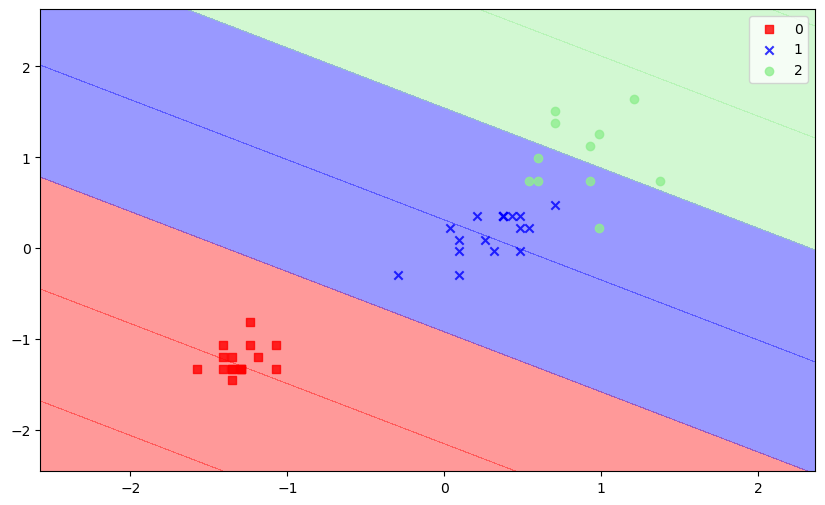
四、SVC(Support Vector Classification)
训练
# ----------标准化数据集----------
# 参考标准化数据集
# ----------SVC----------
from sklearn.svm import SVC
svm = SVC(kernel='rbf', random_state=0, gamma=.10, C=1.0)
svm.fit(X_train_std, y_train)
print('The accuracy of the svm classifier on training data is {:.2f} out of 1'
.format(svm.score(X_train_std, y_train)))
print('The accuracy of the svm classifier on test data is {:.2f} out of 1'
.format(svm.score(X_test_std, y_test)))
''' 输出:
The accuracy of the svm classifier on training data is 0.95 out of 1
The accuracy of the svm classifier on test data is 0.98 out of 1
'''看起来我们的分类器表现得很好。让我们可视化模型如何对测试数据中的样本进行分类。
可视化
# ----------标准化数据集----------
# 参考标准化数据集
# ----------SVC----------
from sklearn.svm import SVC
svm = SVC(kernel='rbf', random_state=0, gamma=.10, C=1.0)
svm.fit(X_train_std, y_train)
# ----------可视化方法----------
def plot_decision_regions(X, y, classifier, test_idx=None, resolution=0.02):
# 详见可视化方法
pass
# ----------SVC可视化----------
plot_decision_regions(X_test_std, y_test, svm)
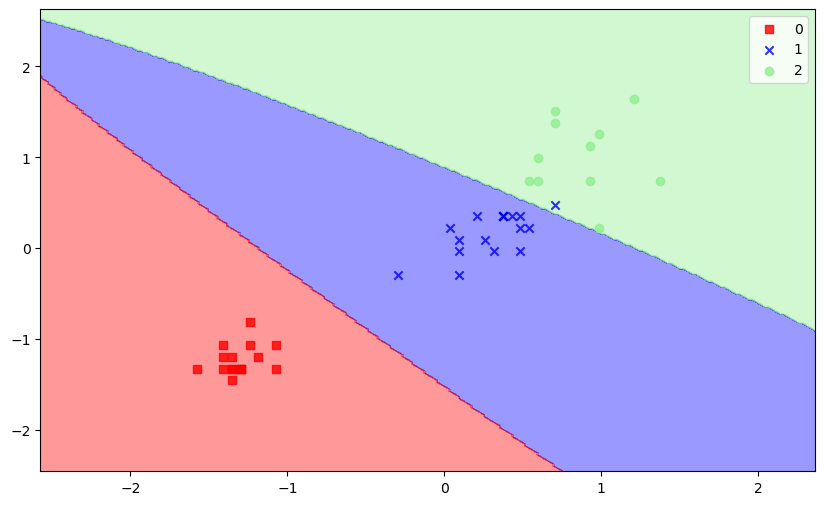
五、KNN(K-NearestNeighbor)
训练
# ----------标准化数据集----------
# 参考标准化数据集
# ----------KNN----------
from sklearn.neighbors import KNeighborsClassifier
knn = KNeighborsClassifier(n_neighbors=5, p=2, metric='minkowski')
knn.fit(X_train_std, y_train)
print('The accuracy of the knn classifier is {:.2f} out of 1 on training data'
.format(knn.score(X_train_std, y_train)))
print('The accuracy of the knn classifier is {:.2f} out of 1 on test data'
.format(knn.score(X_test_std, y_test)))
''' 输出:
The accuracy of the knn classifier is 0.95 out of 1 on training data
The accuracy of the knn classifier is 1.00 out of 1 on test data
'''可视化
# ----------标准化数据集----------
# 参考标准化数据集
# ----------KNN----------
from sklearn.neighbors import KNeighborsClassifier
knn = KNeighborsClassifier(n_neighbors=5, p=2, metric='minkowski')
knn.fit(X_train_std, y_train)
# ----------可视化方法----------
def plot_decision_regions(X, y, classifier, test_idx=None, resolution=0.02):
# 详见可视化方法
pass
# ----------KNN可视化----------
plot_decision_regions(X_test_std, y_test, knn)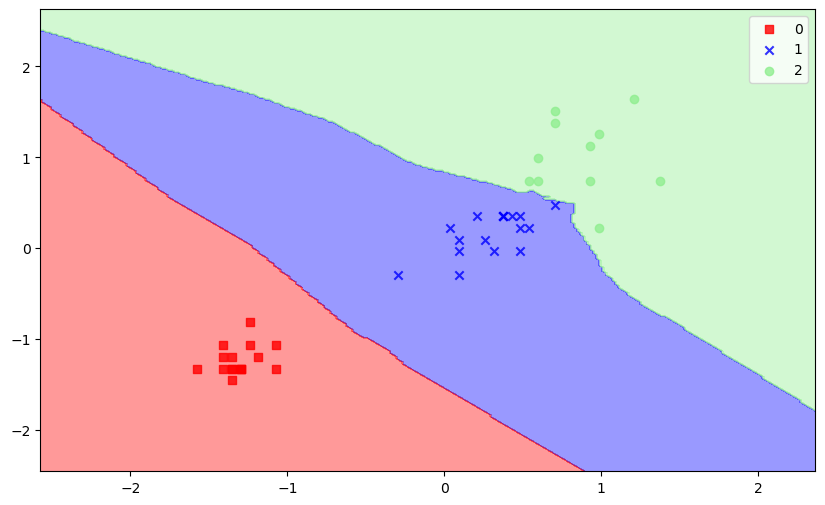
六、XGBoost
训练
# ----------标准化数据集----------
# 参考标准化数据集
# ----------XGBoost----------
import xgboost as xgb
xgb_clf = xgb.XGBClassifier()
xgb_clf = xgb_clf.fit(X_train_std, y_train)
print('The accuracy of the xgb classifier is {:.2f} out of 1 on training data'.format(xgb_clf.score(X_train_std, y_train)))
print('The accuracy of the xgb classifier is {:.2f} out of 1 on test data'.format(xgb_clf.score(X_test_std, y_test)))
''' 输出;
The accuracy of the xgb classifier is 0.99 out of 1 on training data
The accuracy of the xgb classifier is 0.98 out of 1 on test data
'''可视化
# ----------标准化数据集----------
# 参考标准化数据集
# ----------XGBoost----------
import xgboost as xgb
xgb_clf = xgb.XGBClassifier()
xgb_clf = xgb_clf.fit(X_train_std, y_train)
# ----------可视化方法----------
def plot_decision_regions(X, y, classifier, test_idx=None, resolution=0.02):
# 详见可视化方法
pass
# ----------XGBoost可视化----------
plot_decision_regions(X_test_std, y_test, xgb_clf)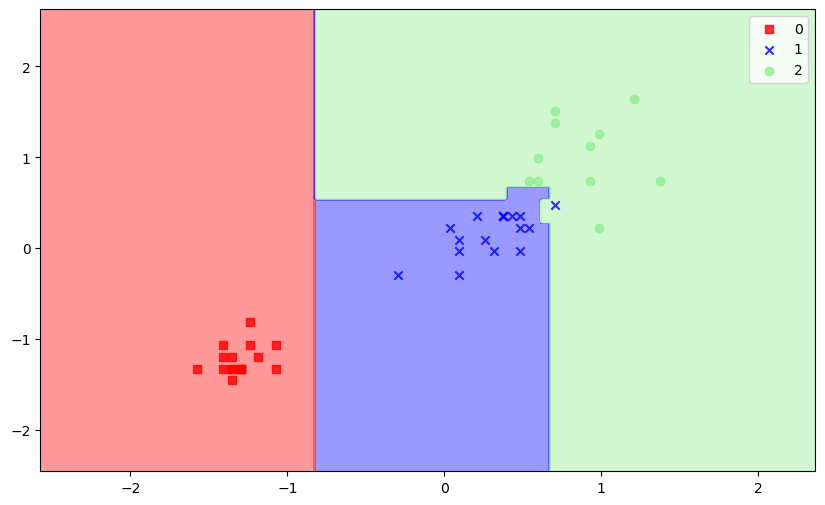 七、随机森林(Random Forest)
七、随机森林(Random Forest)
训练
# ----------标准化数据集----------
# 参考标准化数据集
# ----------Random Forest----------
from sklearn.ensemble import RandomForestClassifier
rfc = RandomForestClassifier(n_estimators=25,oob_score=True)
rfc.fit(X_train_std, y_train)
print('The accuracy of the linear regression classifier is {:.2f} out of 1 on training data'
.format(rfc.score(X_train_std, y_train)))
print('The accuracy of the linear regression classifier is {:.2f} out of 1 on test data'
.format(rfc.score(X_test_std, y_test)))
''' 输出;
The accuracy of the random forest classifier is 0.99 out of 1 on training data
The accuracy of the random forest classifier is 0.96 out of 1 on test data
'''可视化
# ----------标准化数据集----------
# 参考标准化数据集
# ----------Random Forest----------
from sklearn.ensemble import RandomForestClassifier
rfc = RandomForestClassifier(n_estimators=25,oob_score=True)
rfc.fit(X_train_std, y_train)
# ----------可视化方法----------
def plot_decision_regions(X, y, classifier, test_idx=None, resolution=0.02):
# 详见可视化方法
pass
# ----------Random Forest可视化----------
plot_decision_regions(X_test_std, y_test, rfc)